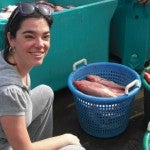In the United States today, 65% of all fish caught in federal U.S. waters comes from catch share programs, which helped drive a 17 year high in fish landings last year. We are continuing to see evidence that catch shares can help to rebuild fish populations while providing fishermen with more stable and profitable jobs as the stock recovers. Last year was exciting and productive for our Oceans team. We want to look back at the year with you, and look forward to how we will continue working with fishermen and fishery managers to restore fish populations at home and abroad. Our goals for 2013 are to:
- Improve the health and profitability of U.S. commercial fisheries and ocean ecosystems
- Advance Pilot Projects that improve recreational fisheries by partnering with recreational fishermen
- Promote catch shares internationally
- Work with fishery stakeholders and scientists to improve science, data collection and monitoring in both catch share and non-catch share fisheries for improved management.
2012 Accomplishments:
United States:
- In 2011, just three catch share programs (the Pacific Groundfish IFQ, New England sector program, and the Gulf of Mexico Red Snapper IFQ programs) saved nearly 16 million pounds of fish from being wasted last year as discards—enough to feed about one million Americans their seafood for a year.
- In the Pacific Region, January 2012 marked the first-year anniversary of a catch share management program for more than 60 species of commercially important groundfish. EDF played a key role in the program’s development, and we are working hard to ensure its durability. In the first year, West Coast fishermen discarded 80% fewer fish than in the previous year, and their revenues reached $54 million—42% higher than the previous five-year average (2011 NOAA Report). Read More












